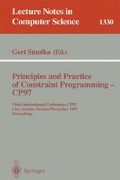Abstract
We present a network flow based, degree of freedom analysis for graphs that arise in geometric constraint systems. For a vertex and edge weighted constraint graph with m edges and n vertices, we give an O(n(m + n)) time max-flow based algorithm to isolate a subgraph that can be solved separately. Such a subgraph is called dense. If the constraint problem is not overconstrained, the subgraph will be minimal.
For certain overconstrained problems, finding minimal dense subgraphs may require up to O(n 2 (m + n)) steps. Finding a minimum dense subgraph is NP-hard. The algorithm has been implemented and consistently outperforms a simple but fast, greedy algorithm.
Supported in part by NSF Grants CDA 92-23502 and CCR 95-05745, and by ONR Contract N00014-96-1-0635.
Supported in part by NSF Grant CCR 94-09809.
Preview
Unable to display preview. Download preview PDF.
References
S. Ait-Aoudia, R. Jegou, and D. Michelucci. Reduction of constraint systems. In Compugraphics, pages 83–92, 1993.
W. Bouma, I. Fudos, C. Hoffmann, J. Cai, and R. Paige. A geometric constraint solver. Computer Aided Design, 27:487–501, 1995.
S. C. Chou, X. S. Gao, and J. Z. Zhang. A method of solving geometric constraints. Technical report, Wichita State University, Dept. of Computer Sci., 1996.
G. Crippen and T. Havel. Distance Geometry and Molecular Conformation. John Wiley & Sons, 1988.
S. Even and R. Tarjan. Network flow and testing graph connectivity. SIAM journal on computing, 3:507–518, 1975.
L.R. Ford and D.R. Fulkerson. Flows in Networks. Princeton Univ. Press, 1962.
I. Fudos. Geometric Constraint Solving. PhD thesis, Purdue University, Dept of Computer Science, 1995.
I. Fudos and C. M. Hoffmann. Constraint-based parametric conics for CAD. Computer Aided Design, 28:91–100, 1996.
I. Fudos and C. M. Hoffmann. Correctness proof of a geometric constraint solver. Intl. J. of Computational Geometry and Applications, 6:405–420, 1996.
I. Fudos and C. M. Hoffmann. A graph-constructive approach to solving systems of geometric constraints. ACM Trans on Graphics, page in press, 1997.
T. Havel. Some examples of the use of distances as coordinates for Euclidean geometry. J. of Symbolic Computation, 11:579–594, 1991.
C. M. Hoffmann. Solid modeling. In J. E. Goodman and J. O'Rourke, editors, CRC Handbook on Discrete and Computational Geometry. CRC Press, Boca Raton, FL, 1997.
C. M. Hoffmann and J. Peters. Geometric constraints for CAGD. In M. Daehlen, T. Lyche, and L. Schumaker, editors, Mathematical Methods fot Curves and Surfaces, pages 237–254. Vanderbilt University Press, 1995.
C. M. Hoffmann and J. Rossignac. A road map to solid modeling. IEEE Trans. Visualization and Comp. Graphics, 2:3–10, 1996.
Christoph M. Hoffmann and Pamela J. Vermeer. Geometric constraint solving in R 2 and R 3. In D. Z. Du and F. Hwang, editors, Computing in Euclidean Geometry. World Scientific Publishing, 1994. second edition.
Christoph M. Hoffmann and Pamela J. Vermeer. A spatial constraint problem. In Workshop on Computational Kinematics, France, 1995. INRIA Sophia-Antipolis.
Ching-Yao Hsu. Graph-based approach for solving geometric constraint problems. PhD thesis, University of Utah, Dept. of Comp. Sci., 1996.
R. Latham and A. Middleditch. Connectivity analysis: a tool for processing geometric constraints. Computer Aided Design, 28:917–928, 1996.
E. Lawler. Combinatorial optimization, networks and Matroids. Holt, Rinehart and Winston, 1976.
J. Owen. Algebraic solution for geometry from dimensional constraints. In ACM Symp. Found. of Solid Modeling, pages 397–407, Austin, Tex, 1991.
J. Owen. Constraints on simple geometry in two and three dimensions. In Third SIAM Conference on Geometric Design. SIAM, November 1993. To appear in Int J of Computational Geometry and Applications.
T.L. Magnanti, R.K. Ahuja and J.B. Orlin. Network Flows. Prentice-Hall, 1993.
Dieter Roller. Dimension-Driven geometry in CAD: a Survey. In Theory and Practice of Geometric Modeling, pages 509–523. Springer Verlag, 1989.
O. E. Ruiz and P. M. Ferreira. Algebraic geometry and group theory in geometric constraint satisfaction for computer-aided design and assembly planning. IIE Transactions on Design and Manufacturing, 28:281–294, 1996.
P. Vermeer. Assembling objects through parts correlation. In Proc. 13th Symp on Comp Geometry, Nice, France, 1997.
W. Wunderlich. Starre, kippende, wackelige and bewegliche Achtflache. Elemente der Mathematik, 20:25–48, 1965.
Author information
Authors and Affiliations
Editor information
Rights and permissions
Copyright information
© 1997 Springer-Verlag Berlin Heidelberg
About this paper
Cite this paper
Hoffmann, C.M., Lomonosov, A., Sitharam, M. (1997). Finding solvable subsets of constraint graphs. In: Smolka, G. (eds) Principles and Practice of Constraint Programming-CP97. CP 1997. Lecture Notes in Computer Science, vol 1330. Springer, Berlin, Heidelberg. https://doi.org/10.1007/BFb0017460
Download citation
DOI: https://doi.org/10.1007/BFb0017460
Published:
Publisher Name: Springer, Berlin, Heidelberg
Print ISBN: 978-3-540-63753-0
Online ISBN: 978-3-540-69642-1
eBook Packages: Springer Book Archive

